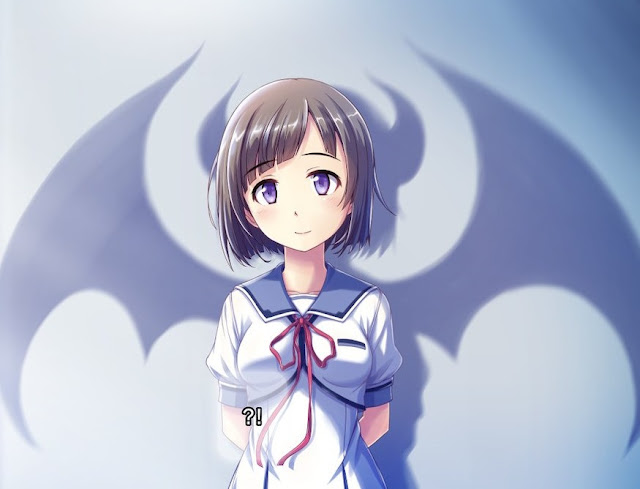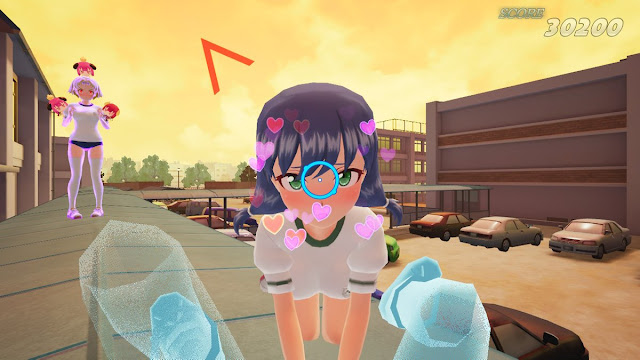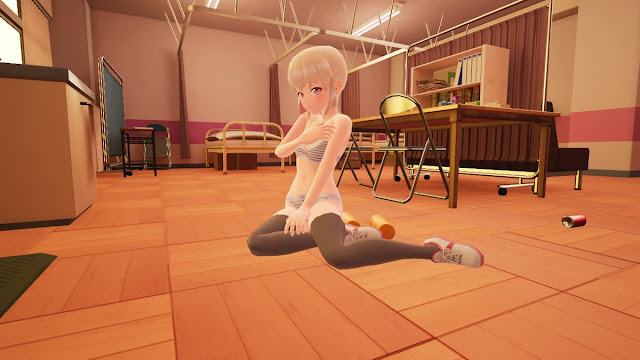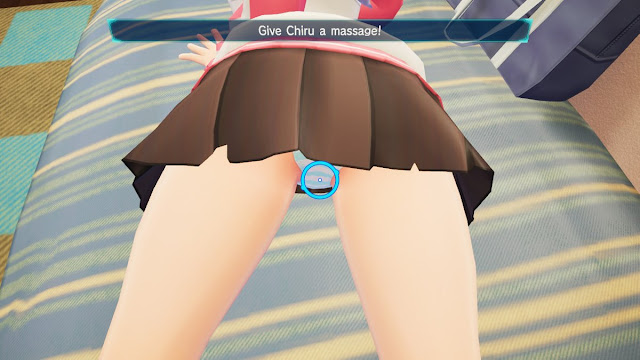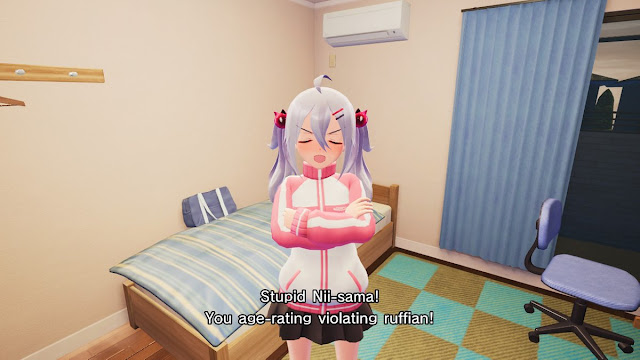Review by Matt S.
Have you ever read Georges Bataille’s work? Particularly his novel Story of the Eye? If not, it’s a useful way to understand and interpret a game like Gal*Gun 2. In fact, Gal*Gun 2 is the perfect example of so much of Bataille’s work and philosophy in motion. This is going to be a controversial game. Even now, many hours out from the embargo lifting, I can already all-but smell the opinion pieces. And it should be. That’s how transgressive art works.
This is, after all, a game that doesn’t hide from its fanservice, and just happens to locate that fanservice within an environment that can be best described as taboo. That’s putting it the diplomatic way. Putting it more bluntly: In Gal*Gun 2, which is set at a school, you play as a student that acquires the ability to use a pheromone gun to bring the girls around you to ecstasy, or alternatively use its secondary function as a kind of vacuum cleaner that can rip the uniforms right off them.
Like I said. Taboo. Gal*Gun 2 explicitly breaks with a whole bunch of taboos.
So let’s get back to Bataille and the Story of the Eye. The Story of the Eye is a short novel that was considered pornographic for the longest time for breaking all kinds of taboos associated with sex and sexuality, until on further analysis people started to come to the conclusion that the metaphors were too strong to be “mere” offensive smut and that’s when it was re-evaluated as an example of transgressive literature. Transgressive literature being a genre in which the author breaks down taboos in order to address deeper philosophy (as a side note: you’ve probably heard of Marquis De Sade… he’s an even more famous example of this genre). Story of the Eye becomes increasingly depraved in the sexuality it exhibits as the book pushes on, and it certainly makes for uncomfortable reading. But that’s the point. It’s a book that’s designed to make you fundamentally uncomfortable. It also contains pearlers of quotes such as:
“To others, the universe seems decent because decent people have gelded eyes. That is why they fear lewdness. They are never frightened by the crowing of a rooster or when strolling under a starry heaven. In general, people savour the “pleasures of the flesh” only on condition that they be insipid.”
Not one to limit his philosophy to a single book, at other times, Bataille wrote things such as:
“Eroticism differs from animal sexuality in that human sexuality is limited by taboos and the domain of eroticism is that of the transgression of those taboos. Desire in eroticism is the desire that triumphs over the taboo. It presupposed man in conflict with himself (Death and Sensuality: A Study of Eroticism and the Taboo.”
And, most importantly:
“Extreme seductiveness is at the boundary of horror.”
We don’t need to look far to find examples of what Bataille is talking about. An overwhelming number of horror books, films, and games also heavily feature sex as a theme. You could always guess who was about to die in a slasher film through the 70’s through 90’s the moment a hot young couple started tearing the clothes off each other. In literature, Dracula was a deeply sensual book, and the vampire stories have always wound around sensuality. Going even further back, there’s an entire layer of hell dedicated to lust, and decadence (including activities such as orgies) led to the fall of the Bible’s Babylon. There has always been a very fine line between sexuality and horror, and while there are various psychoanalytical theories and studies on this, insofar as the transgressive artists are concerned, punching through that boundary is a principle concern.
But the “horror” Bataille was talking about was also not just ghosts and whatever that thing in Twilight was. The horror was the grotesque, the repulsive, the offensive. “Horror” to Bataille was that moment where a work tipped over the ledge to distress its audience on some level. And that’s certainly going to be the case with some who play Gal*Gun 2.
But this is all a fundamentally good thing. See, transgressives and the philosophers that wrote literary criticism about transgression, like Bataille, Michel Foucault, and others, went searching for what is termed a “limit-experience,” a point in which they reach the extremes of experiences, breaks down taboos, and in punching through, both challenges, discusses, and confirms those taboos. In the context of the arts, breaking taboos certainly tends to shock and offend, and in doing so, opens dialogue, highlights important topics of discussion, challenges, and ultimately enrichens a person’s knowledge.
Now I’m not suggesting the developers behind the Gal*Gun series are out there reading Bataille and deliberately looking for ways to break taboos and offend people in order to challenge and liberate their minds. I spoke with the Inti Creates team at Tokyo Game Show last year, and I can tell you that that was explicitly not the intent. The team’s goals started and stopped at making something hilarious, silly, and fun to play. And yet, intent aside, transgression is precisely what the team achieved with 2016’s Gal*Gun: Double Peace, which had a sharp sense of satire that exposed and satirised all kinds of issues with the games and anime industry. It was possible to pay more than the price of a new game for a piece of DLC that would let you see through the characters clothes. That wasn’t a mis-price. That’s what the price was set at a none-too-subtle jab at the role of DLC and the perceived value of it in the industry. And, of course, that’s just one example of the way the game was more that willing to be extremely subversive; asking players to open their wallets to play along with a joke pointed at the kind of person to pay for that kind of DLC is sharp.
Oddly enough, Gal*Gun 2’s biggest problem is it doesn’t push into taboos nearly far enough. It is, dare I say, relatively safe. For all the fanservice that is in the game, it is still a step backwards from its predecessor (yes, being able to rip clothes off a girl with a vacuum cleaning device really is a dial down from the previous game), and while Double Peace was a short and linear experience (and thus able to build a narrative rhythm and sense of escalation which meant the steady breaking of taboos could have maximum impact), Gal*Gun 2 is more open in structure, and thematically, that’s not to its benefit. Sure, you’ll be seeing many more hours of panties over the course of a single play, but… well, you get a bit numb to all that. Transgressive art loses its impact if it allows the audience to become numb to it.
That being said, mechanically the openness of Gal*Gun 2 does work towards the game’s benefit. There’s a greater variety in missions than Gal*Gun Double Peace had, and the whole “relationship” system makes far more sense. I don’t think I ever really figured out how you were meant to build a relationship with “minor” characters in the first game. There were a couple of major characters that were the main point of the game, but supposedly any other character could be converted into the ultimate “love interest” role, but I never did bother to figure that out. This time around, between missions, you can call up any girl who you’ve helped out at some point (by completing a mission they’ve set you) to have a rendezvous, and build your relationship up with her that way. For a couple of girls you can also give them candies that you earn through play, which leads to cut scenes.
Those cut scenes are where Gal*Gun 2 tends to push into its most controversial territory. For example, there’s one scene where you get to give a girl a massage, and there really are no inhibitions on where you can massage. That’s the “horror” part of the game, as per Bataille’s philosophy, above. But again, in comparison to the previous Gal*Gun, those moments are far more spaced apart, and it does act to dampen the impact of them to an extent.
But, back to the good. The core gameplay loop is really good, and that comes from someone that doesn’t much enjoy the genre that Gal*Gun belongs to. In fact, that’s been the biggest secret about Gal*Gun over its short history; for all the controversy around the series, light gun shooters don’t actually get much better. As a light gun shooter, you don’t have control over your character’s movement. Rather, you need to defeat enemies that will come in from 360 degrees by shooting them. And by “enemies” I do mean girls that are rushing at your character to profess their love for him. By shooting them a number of times they’ll reach peak ecstasy, melt to the ground, and disappear. Alternatively, each girl has a “weak spot” on her body, and shooting that will knock her out instantly. When the action picks up, you’ll need to be quick to identify those weak spots and hit them, else you’ll be swamped.
Some girls are infested with demons, and you’ll need to shoot those demons off before you can then overwhelm them with pleasure. That’s where the vacuum cleaner comes in. By engaging that instead, you can quickly and efficiently “suck” the demons away (with the added benefit of bringing the girl’s clothes with them). But this vacuum has a power meter, and once it runs out, it takes a while to charge up again.
Finally, you can “zoom in” and look at a girl who’s close enough to you to start to build up a “heart meter”. Fill that up and you will instantly knock out all the other girls in the area. This special attack effectively replaces the doki doki mechanic from the previous game and it unfortunately it’s a poor swap. Doki doki mode gave you a kind of “cut scene” which allowed you to take the girls somewhere beyond esctacy, and was so ridiculous and over the top it added to the satire. This love heart thing lacks for the humour context, and actually feels like the creepiest part of the whole game.
Sadly, while the game is riotously entertaining with a tight, effective, masterfully executed play loop, it also doesn’t quite manage to break away from that gameplay loop being quite thin. It stands on the precipice of having dating sim elements or slice-of-life style storytelling, but constantly drags you back to participate in yet more light gun action. Because levels in Gal*Gun 2 tend to be surprisingly long, the moments between levels feel just like that, moments, the balance just isn’t there, and while the developers clearly had ideas to make this game something more, those ideas aren’t realised in execution.
And yet, while I can easily pick out bits and pieces here and there that I would have liked to have seen done differently, I don’t feel like any of it pulls down on the game. Gal*Gun 2 might not be as outrageous as its predecessor, but it’s still going to offend a whole lot of people. It will still probably find itself banned in New Zealand. It still has moments where, playing it on the train on my Nintendo Switch, I was desperately hoping that no one was looking over my shoulder. Let’s just say it’s not the kind of game that’s going to win you friends and sell consoles like Mario Odyssey or Breath of the Wild will. It remains transgressive and effectively so, and at the same time I found myself laughing along with the satire, and the knowingness that the game has that it’s both ridiculous, and certainly playing with many different taboos. Overall the game might be ever so slightly softer, but the willingness to lurch over that edge is still there. It’s still Gal*Gun.
And so, to finish this review in the same way I started it, with a quote form Georges Bataille (because I think he would have approved of this game); “The fact is, that what [Marquis] de Sade was trying to bring to the surface of the conscious mind was precisely the thing that revolted the mind… From the very first he set before the consciousness things which it could not tolerate. (Death and Sensuality: A Study of Eroticism and the Taboo)”. You may well find Gal*Gun 2 to be offensive and intolerable. But that’s all the more reason to experience it and discuss it, and because it’s backed by a really good light gun experience that is bigger and (on balance) better than its predecessor, this game is one of the most playable and interesting transgressive franchises the Japanese industry has ever produced.
– Matt S.
Editor-in-Chief
Find me on Twitter: @digitallydownld
 |
| Please Support Me On Patreon!
|

